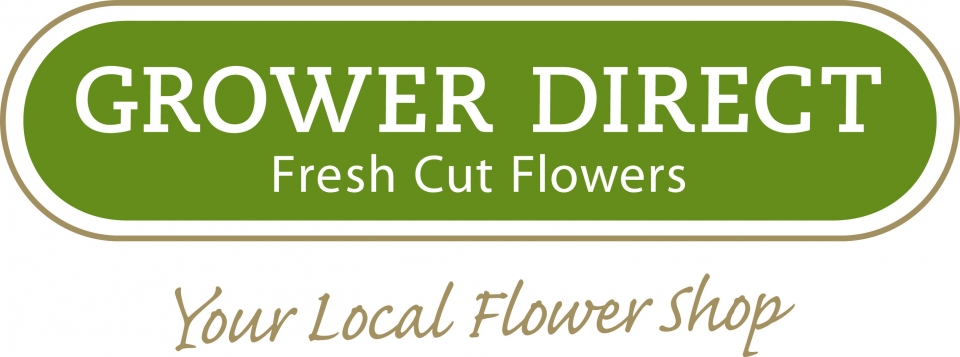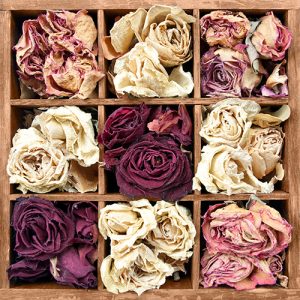![]() Prices in Canadian Dollars.
Prices in Canadian Dollars.![]() Prefer to call and speak to a floral agent? 1-877-277-4787
Prefer to call and speak to a floral agent? 1-877-277-4787
Flowers for Drying
Flowers for Drying
Growing Flowers for Drying : Growing and drying your own materials can be very cost effective, educational and fun too. Often you can produce better quality dried flowers and plants for yourself than you can buy in the shops. When you are first starting out, we recommend trying to dry many types of flowers. Some flowers that did not work well for us may be great for you because of your different drying, storing or handling methods.
There is an enormous variety of plants and flowers suitable for drying for use in craft and floral hobbies. This is a short list of the most common types but there are many more possibilities and we encourage you to experiment.
The family Compositae, sunflowers, asters, daisies, usually do not do well, but there are exceptions like Teddy Bear Sunflowers and some Asters. Anything in the statice family, annual statice, German statice, pink poker statice, dries very well. Most herbs dry well, except basil and members of the family Umbelliferae like dill and its relations but there are exceptions in this family too, like Queen Anne’s Lace and Ammi majus.
Drying
The quality of the finished, dried flower depends very much on the quality of the fresh flower you started with. Most flowers should be picked for drying just before they are fully mature. Make small to medium sized bundles tied with a rubber band (shrinks as the stems dry), and hang to dry in a well ventilated area out of direct light. Most plants will take about two weeks to dry under normal Alberta summer conditions. For detailed drying instructions see the section “Preserving Flowers and Herbs.”
Cultivation
We have found that transplants that have been stressed in the pots before planting, do not recover well and may produce less flowers than plants that have been direct seeded early in the season. Some plants, especially those that self sow, can be planted in the fall to give you a jump on the season. Whenever possible, choose direct seeding over transplants, except for types like strawflowers and annual statice that must be started ahead. Competition from weeds and poor nutrition can reduce the yield from your crop, so it is important to weed and mulch around your plants and to fertilize at least once, usually twice during the season. Extra water is always helpful and will usually give more and larger blooms. See the section on “Pests and Diseases“.
Harvesting
For some flowers like pentzia or xeranthemum, it is inefficient to pick individual stems or flowers. Pick these types bulk, just making large handfuls straight from the row and hang this up to dry. Any further handling is not cost effective. We almost never remove the leaves from the stems of any flowers. For some plants, like yarrow and annual statice it is worthwhile to line up the heads to make the finished bundles more attractive. There are more plant–specific harvesting tips under the detailed plant list following.
Bundle Size
This is approximate in many cases. A woman’s handful, when fresh usually dries down to an acceptable size, but not always. Some types of flowers are made up to industry standards determined by the trade over many years. It is best to go into a shop to see the fresh and dried bundles over the summer harvesting season. Many larger flowers and pods come in 10’s or 25’s. Grains and grasses are usually weighed to 8 oz (225 g) or 4 oz (112 g) bundles. German Statice and flax are often in 1/3 pound, or 5 oz (140 g) bundles.
FLOWERS FOR DRYING
Annual Flowers
Acroclinum Pink or white, daisy type flowers with yellow centers and papery petals like strawflowers. Annual. Direct seed in wide bands in May. Try Double Mixed and Red Bonnie. Will tolerate dry conditions. Pick very young stems in bud, before the flower is open. They will open nicely as they dry. If picked too late the flowers open too much and are unattractive. This is not a big seller, and is fragile when dry. Hang to dry.
Ageratum Purple, blue and white, low growing. Annual. Use transplants. The blue varieties can be useful. Hang to dry in small bundles.
Amaranthus This family of plants is widespread over many continents. In South America some members of this family are important food plants The colorful leaves of Joseph’s Coat Amaranth are edible and added to fancy salads. Red root pigweed is a common weedy amaranth in Alberta.
Amaranthus caudatus. Love Lies Bleeding. Large, soft stems with broad leaves, producing trailing red flowering stalks. Annual. Direct seed in spring. May self sow. Pick trailing dark red spikes with good color, on long stems. Older blooms will fade. Hang to dry. Three or four large stems per bundle with multiple heads. See “Fresh Flowers” information, as this is often used as a novelty fresh cut. Very mature spikes faded to gold can be saved for seed. Often treated with glycerine and burgundy red dye to give a long lasting and durable novelty flower that droops out of the containers.
Amaranthus hypochondriacus. Upright red or green flower spikes on soft, leafy stems. Annual. Direct seed in spring. May self sow. Try Pygmy Torch, a burgundy, red variety that sells well. Pick stems early to avoid shattering of over mature stalks. Hang to dry in bundles of 5 – 7 stems. Mature spikes can be saved for seed. See also “Fresh Flowers”.
Ammi majus. An Umbelliferae with white lacy umbels of flowers. Annual. Direct seed. Pick whole stems in bundles of 7 – 10 stems when most of the flowers are very white and open. Hang to dry. Recommended as a better version of Queen Anne’s Lace, also an Umbelliferae.
Artemesia. Dusty Miller. Annual. Use transplants in spring. Silvery grey leaves on short stems. Broad leaved varieties are the most useful, but the standard type is OK. The fine leaved variety falls apart too much when dry. Good in wreaths a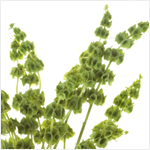 nd potpourri. Pick short handful bundles or cut off the whole plant at the base. Will not be damaged by frost. Hang to dry.
nd potpourri. Pick short handful bundles or cut off the whole plant at the base. Will not be damaged by frost. Hang to dry.
Bells of Ireland. Molucella Biennial. Direct seed in spring for flowers the following summer. Pick fully developed, mature stems, with bells all the way to tip. Hang to dry. Air dried stems will shatter easily. Best in glycerine (20%). 7 stems per bundle.
Celosia. Colorful red, orange, yellow and sometimes pink plumes and heads. Annual. Use transplants in late spring. Very frost sensitive so covering plants in early spring and late summer can extend the season and give more yield. Taller types are more useful but dwarf varieties are good too. Pink colors are preferred but there is some demand for all colors, especially red at Christmas. Try Pink Castle. Cristata (look like brains) and plumosa types (tall spikes) are both good. Wheat Celosia is very good, but may be difficult to grow in Alberta. 7-8 Plumosa stems per bundle. 3-4 Cristata heads per bundle. Bundles should be 6 – 8″ across at tops when fresh and will shrink about 40% during drying. Retain color well for drying. Hang to dry.
Craspedia. Drumstick. Yellow ball flower. Tender perennial. Use transplants. Worth trying. Hang to dry. l5 stems/bundle. Look for a new variety with multiple small balls for the head instead of a single large one.
Dutch Lace Ammobium. Small papery white flowers with yellow centres. like small strawflowers with succulent stems like Statice. Annual. Direct seed in spring. Pick before the majority of flowers are fully open so that the yellow centre is not visible. Like strawflowers, they will continue to open after picking so harvest early. Hang to dry. Shrinks about 60% when drying, so pick large, double handful bundles of multiple stems, not single stems. This is a very nice flower, clear white and easy to use in arrangements.
Geranium. Annual. Transplants. Any scented geraniums are useful for potpourri. Lay out leaves on a metal or cloth screen to dry, or hang the whole plant. Pack in clean plastic bags as soon as crispy dry. Any scented plants or flowers can be used. Bring in plants in fall and use for cuttings for next year.
Gold Button. Pentzia. Cotula. Use transplants or try direct seeding early. Tangly growth so harvest whole plant with mature flowers and good color. Needs full sun. Pick handfuls, fast and bulky. Hang to dry.
Gomphrena. Globe Amaranth. Annual. Often called clover but it’s not related to clover at all. Use transplants or direct seed early. All colors are good but the new strawberry and pink types are the best. Difficult to pick to collect whole plants when most of the flowers are ready. Try for tall stems. Sensitive to frost.
Gourds. Any ornamental gourds, are useful, in all sizes and shapes including pumpkins, but not zucchini. Can be prolific plants. Cure gourds at 75 F (24 C) for 8 – l0 days before storage to harden up the skin. Properly cured gourds will keep for years. Damage to the skin allows entry of pathogens so handle carefully. Don’t poke any holes in gourds, or damage the skin. Once cured, they can be varnished to keep the color.
Herbs. Annual and perennial. Many herbs can be dried and sold for culinary as well as decorative purposes. Try Oregano, Marjoram, Sage, Parsley, Mint, Garlic, pearl onions, Anise Hyssop, Garlic, Catnip,Hyssop, Rue, Savory, and Tarragon.
Larkspur. Delphinium consolida. Annual. Direct seed, as early as possible as larkspur needs cold temperatures and about one month for germination. February, March or early April is not too soon, as soon as you can get into the garden. Fall planted crops do very well. Withstands late summer frosts also, so late repeat planting through the spring can give a continuous harvest. All colors are good, pink is best, followed by mauve, white and blue.
Collect fully opened stalks into bundles of 15 stems and hang to dry. Should be no less than l0″ tall. Very high volume crop. Must be harvested every 2 – 3 days for best quality.
Marigold. Annual. Direct seed early or use transplants. Giant heads are good and will dry fairly well. Try lemon yellow colors as well as bright orange. Hang to dry.
Love in a Mist Nigella. Annual. Easy from direct seed in spring. Try also Nigella orientalis for an exotic shaped pod. Collect seed pods when green, with stripes of red color. Pink flowered varieties have brighter red stripes. Sensitive to frost. Hang to dry. Make handful bundles no less than l0″ tall. Save seed from mature pods.
Poppy Seed Pods Papaver. Annual All types and sizes are useful. Standard pod is l/2 to 3/4 inches in diameter, 25 stems per bundle, extra large, 5 pods/bundle, small pods 35-50/bundle. Hang to dry. Collect pods when they are hard and a clean, golden color. Try Hen and Chicks, also called Italian Spice or Danish Flag, an unusual variety with multiple heads. Put 10 good heads/bundle. Very high volume crop. Wide window of harvesting time. Curled stems are a novelty and well worth collecting. Save seed. Specialty varieties should be planted well away from others to keep seed pure.
Pepper Cress. Lepidium. Annual. Mustard Family. Very easy from seed. May be repeat planted for continuous production. There are many species and varieties in this group all called Pepper Cress or Pepper Grass. Lens podded false flax and globe podded false flax are weeds in Alberta farm land. Pick these as seed pods, when green, but well formed, or fully mature and golden. The lens podded variety is a better seller. Lepidium densiflorum is a short, bushy common weed but can be a useful filler if picked green. Commercial, imported pepper grass appears to be perennial peppergrass, Lepidium latifolium, also a weed species in the US. Can save seed.
Stocks. Annual. All colors are good. Choose double flowered, 10 week stocks, not dwarf or evening scented Stockstocks. Use transplants, or direct seed very early. Harvest often, just before flower stalks are fully mature. Can get multiple cuts from early planted crop. Frost resistant. Hang to dry. Will keep its pleasant fragrance when dry.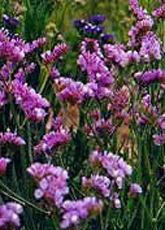
Statice. Many types of everlasting flowers in this family, all are good for drying, and some are very high volume crops.
Annual Statice. Statice limonium. Annual. Standard type. Pink, peach, and white, are the most popular colors, followed by light blue, light purple, dark purple and yellow last. Look for new colors, pale pink, sunset blend, apricot, or other variations. Seed germinates quickly for bedding plant production. Use large transplants for best harvest. Plant on 12″ centres to crowd out weed.
Pick every 2 – 3 days when flower stalks are fully opened for most color. The colored part of the statice flower is actually the calyx, not the petals. The calyx is much more sturdy and will not fade after opening, so you can wait for all the calyces to be open, all the way to the end of the stem, before picking. Mature stems will snap off easily, immature stems will bend. Statice is very sensitive to frost. If you can protect the plants from early frosts you can extend harvesting by a few weeks.
Twelve stalks 18″ long or l5-l8 stalks 12″ long per bundle. Line up flower heads when picking. Hang to dry. Can be treated with glycerine (20%) mixed with green dye, to color the stems and make them more flexible and resistant to shattering.
Rattail statice Statice suworowii. Russian Statice. Pink Poker. Annual. Use transplants or try direct seeding. Pick when flower stalk is fully developed, and good pink color, late in the season.
Strawflowers Helichrysum. Annual. Pink types are always the best sellers, followed by salmon, white, red, purple then yellow and orange. Seed mixes have too much yellow so order seed by color. Buy large transplants for best yield. Sensitive to frost at end of season, so it may be worth protecting the plants in mid August to extend the harvest a few more weeks.
Stems shorter than 6″ are not useful, so make these into heads only or wired heads. Must be picked very young, when only a few rings of petals are open. Harvest every 2 – 3 days for best quality.
When picking heads only it helps the plant if you cut off the stubs of the picked stems every week or so to allow the plant’s energy to go into new flowers rather than green, non-flowering stems.
To wire heads leave a short stem l/4 – l/8″ long at base of flower and insert 20 – 25 gauge wire into the stem only, not into the flower head. Wires can be 6 – 9″ long. Hang to dry in bundles of 12 or 25. Best to sort by color when possible, or shades of pink, shades of yellow.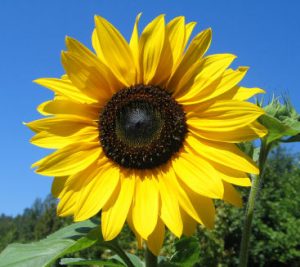
Sunflowers. Helianthus Annual. Direct seed in fall, early spring and every week until end of July for continuous harvest of fresh flowers. Any variety of fresh sunflowers are very good sellers, much better than dried. Colored varieties, red, bicolor, orange, very good for fresh cut, but not good for drying. Taller stems are less sensitive to frost so you can often pick late blooms in mid October.
Teddy Bear is a double flowered, yellow dwarf variety very good for drying. Try also Sun Gold, another double flowered type with a fringe of large petals, and longer stems. Hang these in bundles of 3 stems with the heads staggered. May take up to 4 weeks to dry. Regular sunflowers do not dry well. For best results, try drying mature seed heads. Don’t leave the seed heads outside too long, the birds will eat the seeds and the heads will be less attractive. Even small seed heads are useful in arrangements.
Xeranthemum. Annual. Direct seed. Papery flowers like strawflowers in shades of mauve and white, sometimes pink. Very good for drying. All colors are good. Shear whole plants, once early to get an even stand and once very late to harvest in large handfuls. Sensitive to frost.
Perennial Flowers
Artemesia. Sage. Many varieties. Silver King and Silver Queen are good. Pick handfuls of leafy stems, or when flowers are in bud, but not opened. Culinary Sage is also good for drying. Try also native plants Wormwood (Artemesia ludoviciana) and Pasture Sage. There are many types of wild and cultivated members of this family and almost all of them are good for drying, retain their fragrance and have an interesting silver/grey/green color. Hang to dry. Artemesia absinthum has a terrible smell and does not dry well, easy to identify by the smell.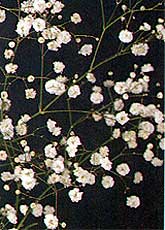
Baby’s Breath. Gypsophila paniculata. Can be direct seeded, but it is usually better to start transplants ahead. The common type is a single flowered, robust plant with a long tap root which does not transplant well. Baby’s Breath is a good, drought resistant competitor, and can survive well even in weedy gardens. Pick when very white with full open flowers. Put 5 – 7 large stems, full height, or 10 stems 18″. Mature stems will snap when ready. Over mature flowers will appear grey or dark don’t pick these. You may be able to collect seed from these later in the season. Hang to dry. Good fresh or dried. Try putting fresh stems in 20% glycerine in water for a few days. Can be stem dyed at this time too.
It can be found escaped from gardens, growing wild all over Canada. Cultivated plants tend to be softer, better quality, with less brittle stems. Needs to be picked every 2 – 3 days when in season, over a 2 – 3 week period. Highly recommended.
Baby’s Breath – Double flowered Gypsophila paniculata. Popcorn type. Same culture and harvest as single flowered. Pick 5 – 7 stems/bundle. Slightly higher price than single flowered. High volume. Highly recommended. In seed packages for double gyp, often there are some single flowered types in the mix.
Carnations. Transplants. Hard to compete with commercial volume and price, but can be worthwhile as fresh cut,dried or as edible flowers. Hang to dry.
Chinese Lantern Physalis franchetti. Usually grown from root (stolon) divisions. Can be invasive. Keep in slightly protected location, vulnerable to frost late in September when lanterns are coloring up. Likes moisture and warm conditions. Pick when lanterns are all orange. Stand up to dry so lanterns hang naturally when finished. Remove leaves by crunching them when dry.
Delphinium. Very good for drying and fresh cuts. Five stems/bundle. All colors are popular, but blue and pink are Delphiniumthe best. Try both dwarf and tall varieties. Try new double flowered varieties with denser flowers. Very fragile so pick slightly immature to reduce shattering. Should be treated with silver thiosulfate in the water after cutting, to prevent petals from falling however, disposal of the silver solution is problematic for any environmentally conscious person. Hang to dry. High volume.
Feverfew Matricaria. Direct seed in late summer, fall or early spring. Self sows. Choose tall varieties. Pick full open flowers before any brown edges appear. Bundles should be 10″ across at top when fresh, no less than 10″ tall.
Globe thistle Echinops ritro. Transplants. Very tough, drought resistant plant. Slow to spread, not a weed problem in Alberta, but reported to be a problem in eastern Canada. Can self sow in protected areas. Cut 6 – 8 long stems with multiple flower heads before the small purple, dainty florets appear on top of the spiky ball head and while the ball is still deep blue. Hang to dry. High volume. Will not produce in first year after planting. Second or third year will give good yields and plants are reported to be very long lived. Difficult to transplant to new locations because of the long taproot. Highly recommended.
Hydrangea. White variety, Annabelle grows in Alberta. Leave blooms to dry on the bush until late in September. Flowers will look and feel papery when done. Hang to dry. See BC Flowers.
Iris Seed Pods. All irises will produce interesting seed pods. Pick when fully mature, nut brown. 25 stems/bundle.
Lavender. Lavendula vera. Seed germinates easily for bedding plant production. Transplants. Plant in sheltered location, usually east facing, to prevent early thawing in spring and drying out over winter. Mulch over winter is helpful. Pick flower stalks when fully open with good color. 25 stems/bundle. Leaves, stems and flowers good for potpourri.
Lemon Drop Centaurea macrocephala. Related to Bachelor Buttons. Coarse, large seed pods good for drying. Pick flower buds, or open flowers with yellow tufts or after flowers are finished and seed head remains, remove old flower petals. Hang to dry. l0-l5 stems/bundle. Better for Fresh Flowers.
Liatris. Tall purple or white spikes. Plant small bulbs in spring. Tolerates dry conditions. Good fresh or dried. l0 stems/bundle. Relatively easy to grow. Short, native variety, Blazing Star, is valuable for seed.
Lily – Day Lily Pods. Mature Seed Pods 25 stems/bundle. See Herbs edible flowers. Start from divisions of older plants.
Lupines. Lupinus. Very good colors. Good fresh or dried. Start from direct seed in July for flowers following year. Can be some winter kill so mulch well. Cut flower stalks just before fully mature. Hang to dry. l5 stems/bundle. See Fresh Flowers info. Can save seed but colors will revert to pink after a few generations of cross pollination.
Money Plant, Silver Dollar, Honesty. Lunaria biennis alba. Biennal. Prefers shady conditions and extra water for taller plants. Direct seed in May for large plants by fall and good flower production the following year. Easy from direct seeding, so don’t use transplants. 5 – 8 tall stems per bundle. Allow to mature on plant so that seed pods are easy to clean. Related to canola. Best product has outside seed coats removed, leaving inside, translucent membrane. Save seed. This is a very good seller and could be a volume crop.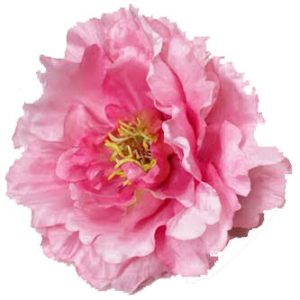
Peony. Paeonia. Use root divisions. Takes several years to full production, so start with a larger root piece if possible. Best colors are light pink and medium pink, followed by maroon and white last. The white flowers will turn brown when drying unless they are dried very quickly in warm conditions. Collect almost full open flowers with no water drops on them. Single flowered types, with few petals are the least useful. Look for double flowered, full heads. Hang to dry.
Pick individual flowers on short stems to get the most blooms, or longer stems with one mature and one or two immature buds for best stem lengths. Hang to dry in bundles of 3 or 5 heads, staggered so the heads are not touching each other. Try also single heads upright through a screen so that the petals open more as they dry. Save loose petals also for potpourri.
Poppy Papaver bracteatum. Best to direct seed as poppies do not transplant well. Needs some sun, not a shady location. Collect petals for potpourri. Sturdiest blooms can be picked in bud for fresh cuts. Small seed pods 35 – 40/bundle. Save seed. See Fresh Flower information.
Rose Rosa spp. All parts of all roses are useful. Most roses are grafted onto hardy root stocks so you need to buy a whole plant from the garden centre. Hansa roses can be started from cuttings, and runners.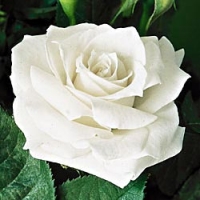
Petals, buds and mature flowers on the stem, can be dried for arrangements and potpourri. Rose hips are useful for teas, and stems 2 feet long with many berries can be used fresh or dried near Christmas, although they are very prickly to handle. Clean, organic roses with good scent can be used for flavoring food and dried petals can be used in rose jelly and cakes. Fresh, small flowers are very good for edible flowers.
Roses are one of the few flowers that retain their scent after drying. Pick wild roses, bulk, with buds, and leaves for Prairie Rose potpourri. Rugosa or Hansa roses have the best scent. Pick partially opened buds on short stems for gluing onto wreaths. Pick opened flowers before they open too far and fall apart, hang to dry in bundles of 6 with staggered heads. Collect loose petals of over blown roses and dry on a screen or flat cardboard box for potpourri.
Spray roses are especially attractive, harvest when most of the flowers are open, but not too mature. Pink, peach, salmon, white, are best colors.
Sea Holly. Eryngium planum. Direct seed in early August for flowers the following year. Look for new, improved varieties with better color, larger heads and multiple heads. Pick when seed pods and stems are bright blue. Self sowing, can be invasive. 5 large stems 30″ or 10 small stems 18″/bundle. Hang to dry. There are several species and varieties of sea holly available now.
Sea Holly – Giant Eryngium giganteum. Very striking large spiky heads. Same handling as Sea Holly, but less stems/bundle. Could be a big seller. Recommended.
Sea Pink Thrift. Armeria. This has a very short stem, which reduces its usefulness. Try picking flowers just before fully mature, while still colorful. Hang to dry. 25 stems per bundle.
Statice All varieties of perennial statice are good for drying. As with annual statice, the calyx is left behind after the tiny true flowers have finished. You can wait for all the calyces to be fully developed all the way to the end of the stem before picking.
Caspia. Statice capsica. Very airy, fine flowers, like good baby’s breath. Tender perennial. Use transplants and mulch for winter protection. May not be fully hardy in Alberta. Pick when fully mature with some blue color still showing. Hang to dry. 5 – 7 stems/bundle. High volume crop.
German statice Statice tatarica. Sturdy stems covered with white, star shaped flowers. Seed germinates easily for bedding plant production. Use transplants. Very good for drying. Pick when all florets have opened to end of stem. Very slow maturing.
One plant produces approximately one large bundle after 3 years growth. Yield improves after 3rd year. Hang 5 – 10 bundles on a string hooked to the ceiling to dry.
Italian statice Statice latifolium. Similar to caspia but much more hardy. Very good for drying. Use transplants. Pick when florets have opened to end of branch. Very slow maturing. Can be left outside to freeze slightly, gives a red color. 3 – 4 stems/bundle. Recommended.
Statice – disease. Aster Yellows. Watch for a virus like disease caused by a mycoplasma organism. Symptoms include yellowing and too straight stems, stunted leaves and flowers. Can be spread by insect vectors and mechanical damage. This disease affects all statice species and many other horticultural and crop plants. There are no control measures except heat treating seed. This is a very serious problem, especially for perennial plantings. If you suspect any plants are infected remove them right away and burn the plants, don’t just put them in the compost. Symptoms may not appear until later in the season after the plants have been stressed by heat or drought.
Yarrow, Parker’s or Yellow Yarrow. Achillea filipendula. Easy from direct seed in spring, late summer, or fall. Will self sow. Very good for drying. Firmer head than millefolium. Same handling as millefolium. Larger plants will make larger stems, so bundles can be l5-20 stems or less. Top of bundle should be 10″ across when fresh. Save seed from mature heads.
Yarrow – Pastel. Achillea millefolium. Shades of mauve, pink, peach, pale yellow and red. Can be direct seeded in spring, late summer or fall. Slow to germinate and requires a cold period for best germination. Pick when flowers are fully open, but not too old. Line up flower heads to make an umbrella shape. Top of the bundle should be 8 – 10 ” across when fresh. Sells better fresh than dried. Hang to dry.
Yarrow – Native Achillea millefolium. Native plant almost always white. Same handling as pastel shades. See Gardening with Native Alberta Plants.
Yarrow – The Pearl. Bridal Veil. Achillea ptarmica. Can be grown from seed, stem cuttings and root divisions. Very good for drying. Same handling as millefolium. Pick when flowers are fully open and clean white. Fresh bundles should be 10″ across. Very good product, recommended for volume growing.
